The Seaplane Company
How to start an airline in 28 days or less!
![]()
Cape Town,
South Africa!![]()
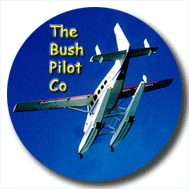
![]() I was in the right seat of
the amphib Caravan flying past Table Mountain in Cape Town, when both the
pilot and myself smelled smoke. I had sensed the smoke, but he mentioned
it first. Neither of us initially recognized the particular smell,
however, as it was not fuel smoke or oil smoke, but rather a damp oily
smell like someone had left a wet oily rag near the exhaust stack.
I was in the right seat of
the amphib Caravan flying past Table Mountain in Cape Town, when both the
pilot and myself smelled smoke. I had sensed the smoke, but he mentioned
it first. Neither of us initially recognized the particular smell,
however, as it was not fuel smoke or oil smoke, but rather a damp oily
smell like someone had left a wet oily rag near the exhaust stack.
Dave, a South Africa pilot, was thinking
hard. He had just completed the pre-landing over flight of Victoria &
Albert Harbour, looking for wind direction and moving boats, and was
setting up on the downwind leg for landing near the mouth of the harbour.
I could see that he was struggling with the concept that we might actually
have a fire on board. We discussed the peculiar odor, but neither of us
could put a finger on the source.
Consequently, Dave flew his downwind a little too
far, and just as he was turning onto a long base the nearby military base
called him on the VHF radio.
 “Oscar Romeo Romeo, you have just entered a restricted military zone,
what are your intentions.” The scenario was setting up perfectly almost
as if I had planned it. I was training Dave on the Caravan amphib and the
more real the life pressure the more I could emphasize the need for
learning and memorizing emergency procedures.
“Oscar Romeo Romeo, you have just entered a restricted military zone,
what are your intentions.” The scenario was setting up perfectly almost
as if I had planned it. I was training Dave on the Caravan amphib and the
more real the life pressure the more I could emphasize the need for
learning and memorizing emergency procedures.
Dave responded to the military tower, “Oscar
Romeo Romeo is just turning base leg for the Cape Town harbour, our
intention is to land there.
“No problem,” responded the military
tower, “Safe landings.” Little did he know that we were on fire.
I was not sure either until I looked back to
ask the other trainee, Charl, if he smelled smoke. To my delight I saw
billowing white smoke pouring out from under Charl’s seat immediately
behind the captain’s seat. “This is too good to be true,” I thought,
“a real emergency.” The best part was Charl did not notice the smoke
either.
I turned to Dave and said, “OK, we have a
cabin fire.” Then I waited for his response. He never responded and
finished his base turn onto final. I
then said, “Dave we have a cabin fire, what are the procedures?”
In the ground school and during the initial
flight training I had emphasized that there are only two types of fires:
fuel fires & electrical fires. Some pilots will argue with that point
and add in cabin fires, but since almost all cabin fires, short of a boy
scout building a tee-pee stick fire in your aisle, are electrical fires
they should be dealt with as such. Therefore, me saying that we had a
cabin fire should have elicited the same response as if I had said we had
an electrical fire. But, again he hesitated.
I looked back and pointed to the billowing
white smoke coming from under Charl’s seat, and Charl suddenly realized
that we were on fire. Not wanting to actually let the fire get out of
hand, I said to Dave, “OK, we have an electrical fire, what are the
procedures.” Dave had just finished his final checks, including full
flap, and was not really responding to the emergency as quickly as I would
have liked. He reached for the battery switch and said, “Well, I would…?”
At that point I interrupted him and said,
“Not that you would, but that YOU WILL. You have an actual fire here.
This is not an exercise. You need to respond.” With that he reached over
with his left hand and flipped off the battery switch, touched the
generator trip switch and flipped off the standby power switch.”
I asked him if he had any popped circuit
breakers, and he looked down and responded that he had none. The smoke
continued to get worse in the cabin and I realized that Dave had not
tripped the generator offline. All the radios and lights were still on. At
this point the fun and games were over and I reached over and redid the
emergency procedures as per the Cessna manual.
Battery switch off,
Generator switch tripped off line, Standby power switch off, Vents closed,
and Bleed Air Heat switch off.
The entire procedure never took me more than 3
seconds, and as suddenly as it had started the smoke stopped.
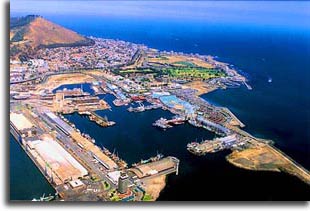
Click on the image for a larger view.
Dave already had the electrical flaps
down so we continued to alight in the harbour. I was extremely pleased
with the fact that the procedures worked. After 3500 hours flying Caravans
this was my first electrical fire. After the fire is out then comes the
"cause" check. That part was easy.
I now leaned over Dave and rechecked the
circuit breakers. Only after we took all power off line did the circuit
breaker pop for the rear overhead vent fan. It was the fan motor burning
up. That explained the odd electrical/oil burning smell. In fact, when the
smell first hit my primordial cortex I had a flashback to the miniature
electric trains and racecars I used to run in our family basement as a
ten-year-old boy. The smell of an electric motor is universal.
Charl, in the meantime, had torn up the back
of the aircraft and under the seats looking for the source of the fire. I
had to laugh as the smoke was actually coming from the overhead vents but
only materialized when the rush of air hit the floor and slowed under his
seat. Thus, the fire extinguisher would not have done much good here. We
only needed to take the power off line for a second and then reestablish.
After docking at the Victoria & Albert Harbour, I tie-wrapped the
circuit breaker open, snagged the motor in the maintenance manual, and
loaded the next set of passengers with out missing a beat.
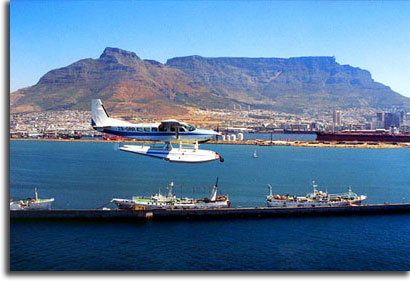
Charl asked me later, “How do you do
that?”
“What?” I asked.
“Make the training so real?”
A couple of days before I had briefed the
pilots on how to manage a brake failure on the Caravan, and then Gert, the
third pilot I was training, had a brake failure after turning onto the
taxi way at the international airport. I was there to talk him through it,
and helped him push the aircraft around to face the right direction as we
walked it back to the hanger. The secret to realistic training is to
conduct the training online and while the aircraft is operational. The
added bonus is that if there is a problem it can be solved quickly by
someone with experience.
It all started when Africair decided to sell
one of our Pan African Airlines amphib Caravans . Meanwhile, a helicopter
company hoping to reinvent itself as a seaplane company was researching
different aircraft that they could use in Cape Town when they came upon my
web site and the story about flying an amphib Caravan for Chevron in
Nigeria. That is the plane they wanted, and ironically, there was one for
sale in Nigeria, and ironically the pilot flying it was the editor of the
web site they had found it on. Small world syndrome strikes again.
After they bought the Caravan, Ingwe
Helicopters had requested that I come to South Africa to help them start
the new seaplane operation using the Cessna 208 on Wipaire amphibious
floats, and train enough pilots to begin their operation. As there is no
seaplane infrastructure in South Africa, and in effect no seaplane pilots,
this was a daunting request considering the time frame in which I had to
work with. Normally I only get 28 days off from my regular job, and this
would be enough time to train several pilots. Considering, however, that
none of the proposed pilots had either floatplane ratings or C208 type
ratings I decided I needed extra time to compete this task and took off an
additional 21 days.
My wife, my eleven-year-old son, and myself,
left Canada on Dec 15 and arrived Cape Town on Dec 17. Dave, who was
to be the Chief Pilot, and Reinhardt, the marketing manager, greeted us at
the airport. We all drove to the wine-farm guest house we were to stay at
and our hosts made sure we were comfortable. As South African Airlines had
temporarily lost our luggage we needed to get to a store for the basics of
toothbrush and shaver. After living in Africa for two years we were
slightly in shock to find the modern and well-stocked grocery stores of
South Africa to be comparable to the stores at home in Canada.
The next day Reinhart drove me to the
harbour to show me around. I had heard from several South African
helicopter pilots that the harbour was just too small and crowded to
operate a seaplane out of and after looking from the dockside I realized
that it was going to be tight. Another problem was that the dock that they
planned to use, made of small plastic cubicles connected together to form
a somewhat tenuous wobbly platform, was not suited for operating an 8000lb
plus Caravan. After several discussions and meeting with the contractor
Mike we decided to use a different existing platform that will be much
more stable if not perfect.
Before we could finalize on the initial
jetty, however, I was called upon to return to Nigeria to bring the
aircraft to Cape Town. I was able to leave Cape Town Dec 19th
for Johannesburg, Nairobi, and Lagos. I arrived in Lagos on Dec 20th
only to discover that, since Pan African Airlines was not expecting me
back until the New Year they had mailed my re-entry visa to Canada, and my
original visa had expired. As it was right before Christmas, I managed to
talk the immigration supervisor in letting me off with a personally paid
fine and I was able to jump into the Caravan and leave Nigeria again the
same day. Naturally I did not have my passport stamped leaving Nigeria as
I had not officially arrived.
The ferry company Pilot International had
everything ready to go, except the ferry pilot did not have a Nigerian
licence. Since the Caravan was to be ferried under the Nigerian
registration, only a Nigerian registered pilot could fly it out. That is
where I came in. I provided the licence and Andre provided the ferry pilot
know-how. Andre was South African and had done this trip many times,
except not in a Nigerian registered aircraft.
We left Nigeria at about 2pm in the afternoon, and
flew direct over Sao Tome to Luanda arriving just after midnight. Over Sao
Tome we encountered some heavy turbulence in a thunderstorm and the entire
ferry tank system consisting of 5-200 liter barrels shifted against the
steel cables holding them fast. I was concerned in that I had just read an
accident report where a Caravan pilot had to ditch when his ferry system
shifted in flight causing a bad leak in the cabin. He was hospitalized and
the aircraft was destroyed in the process.
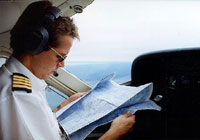 Andre
was unconcerned, however, and that was good enough for me. In the small
world syndrome, I found out later our company in Nigeria had just hired
the same ferry pilot who had ditched the Caravan and he spent several
nights regaling us with this tale of woe.
Andre
was unconcerned, however, and that was good enough for me. In the small
world syndrome, I found out later our company in Nigeria had just hired
the same ferry pilot who had ditched the Caravan and he spent several
nights regaling us with this tale of woe.
In Luanda we were faced with some usual
African delays, but the main one was that they were not going to let us
file direct to Lanseria, South Africa. Unless you could get to 25,000 feet
the war zone over Angola was considered too dangerous to cross. They would
only let us file west along the coast until we reached abeam Namibe and
from there we could proceed direct. This was going to add an hour and a
half to our already long flight. So we took off, climbed to altitude
turned off all our lights and then proceeded direct at the first
opportunity. I figured no rebels would waste an expensive missile on our
Cessna. South African pilots who flew during their little known war in
Angola told me I was wrong; that the rebels loved wasting missiles on
whatever they could shoot at.
The first half of the flight was in the
dark, and I mean real pitch black no stars no moon dark, but the last part
was to be into increasing daylight. I had always wanted to see Botswana
from the air and I got to see it all as we flew low over the Okavango
Delta and past Maun, the home base of many a bush flying outfit. The delta
was not in flood, but there still was lots of water around. The bush was
thin and scattered and it was perfect for game spotting. I saw herds of
elephants and Cape buffalo from above.
From here we cut across the eastern edge of the
Kalahari Desert and I was amazed at how much territory was divided up by
cattle fences. The fences stopped the huge ungulate migrations that took
place in the past. Millions of wildebeest and zebra were killed needlessly
when those fences stopped their natural migration routes. The government’s
idea was to stop the spread of hoof and mouth and rinderpest diseases from
the wildlife to the burgeoning cattle industry herds. Richard and Delilah
Owens, American naturalists, were deported out of Botswana for protesting
these very fences.1
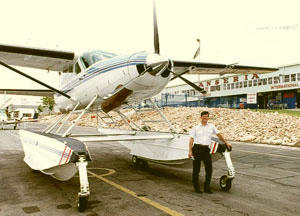 We
arrived into Lanseria on Dec 21st, just after noon. Here I met
Ian the owner of an maintenance engineering company that was contracted to
complete the CofA and transfer the registration. He had been persistent
and tireless in following up the paper work and phone work needed to
see that all the right people and documents were in place to complete the
job. This was seemingly impossible because of not only having to deal with
not one but two African civil aviation authorities, but also to do so
during the week just before Christmas. In fact, the task had been
considered impossible by almost everyone concerned, but Ian had a
reputation for doing the impossible.
We
arrived into Lanseria on Dec 21st, just after noon. Here I met
Ian the owner of an maintenance engineering company that was contracted to
complete the CofA and transfer the registration. He had been persistent
and tireless in following up the paper work and phone work needed to
see that all the right people and documents were in place to complete the
job. This was seemingly impossible because of not only having to deal with
not one but two African civil aviation authorities, but also to do so
during the week just before Christmas. In fact, the task had been
considered impossible by almost everyone concerned, but Ian had a
reputation for doing the impossible.
Moreover, Dave had flown up from Cape Town to
liaison with the local civil aviation in presenting and having approved
the new Ops Manual that Dave had completed with the documents I had
submitted by email in the preceding weeks. Dave not only rewrote the Ops
Manual to work with the South African air laws, but he wrote an excellent
set of SOP's to go with it. The civil aviation was so impressed with
Dave's professional and systematic approach to producing the documents
that they signed us off on the first attempt.
The next day I did the performance test
flight that allowed completing the CofA and registering the aircraft into
South Africa. Although it was absolutely the last work day before the
Christmas break the two South African surveyors agreed to show up with the
understanding that they might not have time to complete the full CofA
inspection. What sped up the process and insured the completion was that I
had personally been through many of these inspections myself and I knew
what they would be looking for. I stayed on hand to answer all of the
surveyors questions and I must admit they were not easy.
When it was all over, however, they were
satisfied with the aircraft and wrote us out the certificate. After it was
all done we passed on our Christmas cheer by dashing them each a bottle of
good scotch. For civil servants they had gone beyond the call of duty to
get the job done and the least we could do was buy them a Christmas drink.
Ian and I had a cold beer to celebrate.
The CofA was finished too late, however,
for us to continue that day, but Dec 23rd, the next day, Dave, Ian, and
myself took the newly christened ZS-ORR to Cape Town. Ian gave me the
radio tags from 5N-WMB as keepsakes and I must admit I did feel some
regret. I hated to lose such a work-horse from our operation in Nigeria.
We flew from Lanseria to Kimberley, where Dave
had me fly over the largest man-made hole in the world. The Kimberly
diamond mine was nothing like I had imagined and difficult to describe. As
we refueled I went to see if I could buy a diamond for my bride, but the
souvenir shop was closed. I was amazed, however, at the bright shiny
refueling truck which could jack up a platform so that the attendant could
fill the Caravan wing easily. South Africa was proving to be unbelievably
modern and efficient unlike the Africa I was used to.
We then continued toward the Cape Town
International. The weather was severe clear and I hardly saw a cloud for
the entire trip. Again the landscape was amazing with dried river beds,
great rift valleys, rock cliffs and often no civilization for miles
around. I was struck by how difficult the Great Trek of the Boers must
have really been over the rugged dry terrain.
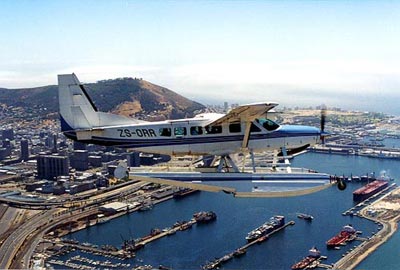
Our arrival in Cape Town was anticipated by
the control tower who unlike other places in Africa actually had received
our flight plan in advance. They had prepared a series of jokes for our
entertainment including one about having a drought in Cape Town and not
being able to flood the runway for our seaplane.
A crowd of well wishers, aviation buffs, and
photographers greeted us on shut down. Here I learned that I was to fly to
the Cape Town V&A Harbour with the National News crew following our
flight with a helicopter. With my hasty departure to get the aircraft from
Nigeria I had not over seen the final preparations for the seaplane dock
so I was rightly concerned about what was awaiting me in the harbour.
Moreover, the aircraft had no ropes. That might sound trivial, but it was
a concern for me as the pilot responsible for the safety of the passengers
and the aircraft. From experience I knew a good rope had often saved a bad
situation when docking in an unfamiliar location.
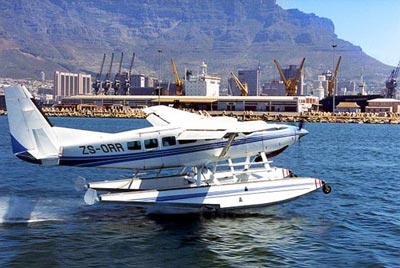
Luckily one of the well wishers was a pilot and a sailor and happened to have some good ropes in her car. Pat Evans was happy to lend us her ropes in return for a ride somewhere down the line. I agreed and kept my promise. Shortly we were airborne with a full load of passengers wanting to experience the first ever landing in the Cape Town Harbour with a Caravan. In fact, as far as I could discern there had only been the WW11 Catalina and a standard Beaver before me.
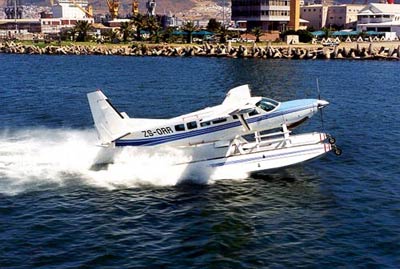
The weather was still clear and the wind was perfect for a first landing. I approached the harbour from the east and made a couple of 1500 foot circumnavigations, more to allow the chase helicopter to take some photographs then to source the landing site out. I had decided what I wanted to do on the first go around. I set up a long approach for the landing right into the harbour mouth allowing the helicopter to come in close and get some great videos and still pictures. I did not want to scare the harbour control who were decidedly nervous about us coming into their area of responsibility, but I also want to show the crowd what an efficient pilot could do. I basically did not want to taxi unnecessarily. I hate taxiing and will do almost anything to avoid it.

I kept the power on and felt for the water. There was a slight underlying swell that I wanted to feel out. I found it by dragging the water gently and felt confident it would not be a problem. At that point I made my decision to commit and pulled the power into beta, lifted the flaps, and hauled back on the elevators. I must admit I stopped her quick partly for the dramatic effect of getting the nose way in the air and partly to avoid hitting any errant boat wake that I might have overlooked. Pulling the Caravan to a full stop is like bringing a galloping horse to a stop by pulling on the reins and having her lock all fours. Lucky for prosperity two professional photographers were on hand to record the event.
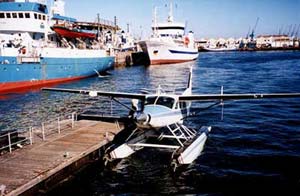 Once I landed at the V&A waterfront and taxied into the harbour, I was
very relieved to realize that the harbour was going to be an acceptable
place in which to operate a seaplane. The harbour was protected enough for
us to fly out of in all except the worst of the gale force winds that
frequent the Cape. After proving the flight the airline was basically open
for business. From the time I did the pre-buy test flight with the soon to
be new owner in Lagos, until the time we were operational was less than
one month -- 27 days to be exact.
Once I landed at the V&A waterfront and taxied into the harbour, I was
very relieved to realize that the harbour was going to be an acceptable
place in which to operate a seaplane. The harbour was protected enough for
us to fly out of in all except the worst of the gale force winds that
frequent the Cape. After proving the flight the airline was basically open
for business. From the time I did the pre-buy test flight with the soon to
be new owner in Lagos, until the time we were operational was less than
one month -- 27 days to be exact.
I spent the next month training and certifying the
South African pilots and at the same time doing the many requests for
revenue producing charters and scenic flights that would help bolster the
newly formed company. I must admit that South Africa continued to amaze me
with its juxtaposition of wilderness landscape and modern infrastructure
that you simply do not find else where in Africa.
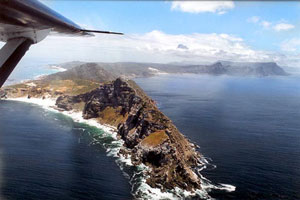 The
highlight of our visit was to fly past Cape Good Hope and Cape Point to
over fly the southern most tip of the African continent, Cape Agula. With
this flight I had completed a personal milestone by flying the length of
Africa. My first trans-African flight had been from Lagos to North Africa
and the Mediterranean across the Sahara Desert in a Turbo-Beaver and now I
had flown from Lagos to Cape Agula in a Caravan amphib. What more could a
bush pilot from Canada ask for?... except maybe for someone to pump the
floats at the end of a long day.
The
highlight of our visit was to fly past Cape Good Hope and Cape Point to
over fly the southern most tip of the African continent, Cape Agula. With
this flight I had completed a personal milestone by flying the length of
Africa. My first trans-African flight had been from Lagos to North Africa
and the Mediterranean across the Sahara Desert in a Turbo-Beaver and now I
had flown from Lagos to Cape Agula in a Caravan amphib. What more could a
bush pilot from Canada ask for?... except maybe for someone to pump the
floats at the end of a long day.
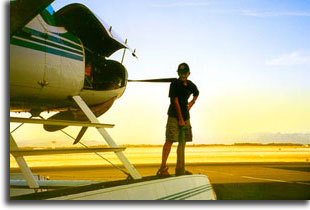
After a memorable day, Logan volunteers to
pump the floats.
Article by John S Goulet
Continue here for more Photographs of the South Africa Odyssey.
![]()
Note from the Editor. 1 See "The Eye of the Elephant" in the "Inside Africa" Section for more about bush pilot Richard Owens.
![]()
The attitude indicator will guide you back to
Knowledge Based Stories.
 Top of this page.
Top of this page.
The
Bush Pilot Company
Last modified on
March 05, 2006 .
© Virtual Horizons, 1996.